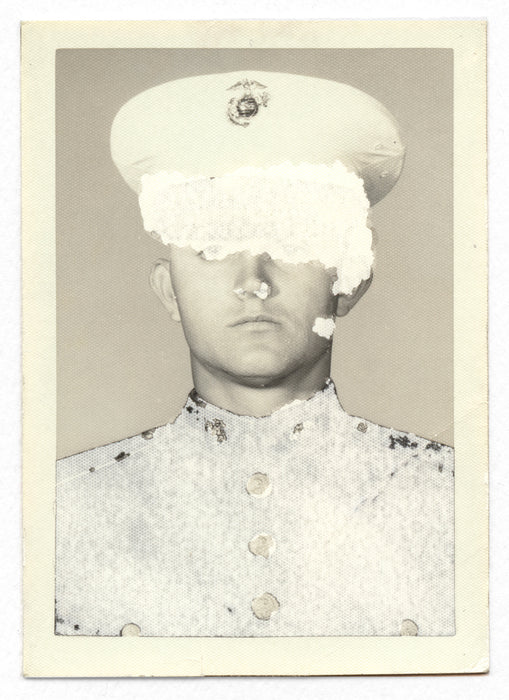Featured image: Love Letter to the Unnamed, Jason Tucker, 2024, mixed media, 4 x 2 in. / 10.16 x 5.08 cm.
In his haunting series of silver gelatin mordançage prints, Jason Tucker excavates the emotional terrain of American masculinity, queer identity, and historical erasure.
Jason Tucker reworks found photographs using mordançage to explore queer identity, masculine mythologies, and the delicate violence of memory.
Through a delicate process that chemically lifts and distresses the photographic emulsion, each image teeters between presence and disappearance. His work does not merely archive the past, it corrodes and reanimates it, revealing the fragility of memory and the myths imposed on male identity. The following three works from this ongoing body of work each offer a unique vantage on how touch, posture, and togetherness echo across time.
Explore our curated selection of contemporary artists from around the globe.
Naturalist Gallery offers artist representation internationally. Apply your art.
The Way They Taught Me to Stand, Jason Tucker, 2020, mixed media, 5 x 3.5 in. / 12.7 x 8.89 cm.
The Way They Taught Me to Stand confronts the viewer with a double portrait partially obliterated by chemical decay. One man sits while another stands close behind, their forms breaking into abstract textures. The title speaks volumes, it suggests a legacy passed down, perhaps from soldier to son, or father to boy. The corrosive surface acts as both veil and evidence, gesturing toward how traditional masculinity is internalized and eroded. Tucker lets us glimpse this indoctrination not as nostalgia, but as a phantom still haunting the present.
In Spite of Ourselves, Jason Tucker, 2024, mixed media, 5 x 3 in. / 12.7 x 7.62 cm.
In Spite of Ourselves presents a dapper pair, suited and hatted, their outlines faint and nearly dissolved. Here, Tucker leans into irony, the title, borrowed from a John Prine love song, suggests intimacy and resilience, but the damage done to the emulsion reveals something more elusive. These men are barely there, consumed by time and process. What remains is not just their likeness, but their resistance, standing together despite history’s erasures.
A History Made of Touch, Jason Tucker, 2024, mixed media, 5 x 3 in. / 12.7 x 7.62 cm.
A History Made of Touch is perhaps the most tender of the three. Two sailors, arms wrapped around each other, beam toward the lens in an image that resists shame. But again, the mordançage eats away at their midsections, ghosting out their bodies while preserving their expressions. The photograph becomes a metaphor for queer memory: intimate, vulnerable, and constantly under threat of fading. The physical act of touch is immortalized, even as the image disintegrates.
Together, these works form a quiet rebellion. Tucker’s practice mines found photographs for what they hide, unspoken affections, coded gestures, and the ephemera of queer presence in a hypermasculine past. Through the destructive beauty of mordançage, he asks us to reconsider how we inherit identity and what gets lost in translation. Memory, in Tucker’s hands, is not fixed, it bleeds, curls, and transforms.
Learn more About Naturalist Gallery of Contemporary Art.
Hill & Barrett (The Light is No Mystery), Jason Tucker, 2020, mixed media, 4 x 2 in. / 10.16 x 5.08 cm.
You may also find the following articles helpful:
The 14 Essential Artists of Impressionism
Expressionism: 20 Iconic Paintings & Their Artists
Renaissance Art: Origins, Influences, and Key Figures
Classical Art Movement: Exploring the History, Artists, and Artworks
Figurative Art: Understanding, Collecting, and Appreciating the Style
Daily Routines of Famous Artists: Learn from the Masters
Top 12 Controversial Artworks That Changed Art History





